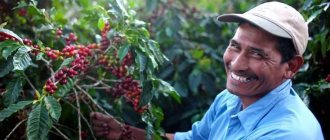Coffee trees have a limited growing range. They bear fruit only near the equator - no further than the tenth southern and tenth northern parallels. The areas where coffee grows form the so-called coffee belt. The air temperature here does not drop to the destructive level of 0 °C. Humidity, precipitation, soil composition, and altitude also matter.
Countries that have favorable conditions for the growth of Arabica and Robusta produce them for domestic consumption and for export.
Coffee Belt of the Planet
Coffee grows in 65 countries, and almost all of them supply beans to the international market.
Coffee trees are very demanding on environmental conditions - they need a very special climate. This forms the unique distribution area of the plant.
- All countries in which coffee trees can be found are located along an imaginary strip of the earth's surface that extends along the equator. This projection onto the geographic map of the Earth is called the Coffee Belt.
- The Earth's coffee belt is limited to tenths of the southern and northern latitudes. These regions are also called the Tropic of Cancer in the northern hemisphere and the Tropic of Capricorn in the southern hemisphere.
- Such an interesting habitat is not unusual. It's all about unique climatic conditions - the predominance of humid and warm weather without sharp fluctuations and frosts on the ground surface at night. A rapid drop in ambient temperature is extremely dangerous for finicky coffee trees.
- It is believed that the birthplace of coffee is Ethiopia. From there the plant began its journey around the world, but was able to take root only in regions with a similar mild equatorial climate.
Reference. The geography of coffee distribution is limited to Central Africa, South and Central America and the countries of Southeast Asia.
How does a coffee tree grow?
Plants are grown on plantations located at an altitude of at least 1000 and a maximum of 2500 meters. To understand where coffee comes from, you need to consider this process step by step:
- The seeds are processed and placed in containers to allow them to germinate. The appearance of the first shoots is observed after ten weeks.
- When the seedlings reach a height of five centimeters, they are transplanted into larger containers and moved to a greenhouse.
- For 6-12 months the plant is kept in greenhouse conditions. During this period, its height reaches at least thirty centimeters. After this, it is moved to open ground. It is extremely important that the sun's rays fall on the tree at an angle.
- The plant blooms for the first time closer to three years of life. The flowers are white, similar to jasmine. Fruits are not always set during this period. Often the appearance of berries is noted after a year.
- Flowering occurs within a maximum of two days. After this, the petals begin to fall off and fruits begin to set. Visually, they are similar to cherries and have the same size, shape and color.
- A full harvest is harvested when the tree reaches five years of age. The berries take on a purple or reddish hue.
- The duration of fruit ripening directly depends on the variety. Some take eight months, others eleven.
Harvest dates vary in different regions. If in Brazil this is the period from May to September, then in South America - from October to March, and in South Africa - from the last days of October to April.
The tree can reach nine meters in height. The largest yields can be obtained from the eighth to the fifteenth year of plant cultivation. Subsequently, productivity decreases, but fruiting does not stop until fifty years.
In which countries does coffee grow?
In each zone of the Coffee Belt, there are leading countries in the cultivation and export of beans.
South America
Brazil. A third of the world's coffee harvest (about 40 million bags) is harvested here every year. In addition, many varieties grow here - both Arabica and Robusta. The flavor characteristics of beans from Brazil make them suitable primarily for the production of various mixtures and blends for espresso. Brazilian coffee also has a fairly affordable price.
Colombia is Brazil's eternal rival.
This Latin American state cannot boast of such a huge harvest as in Brazil - about 10-13 million bags are harvested here every year. But the consumer characteristics of the beans are still much higher, since only Arabica is grown in the country. Today Colombia has 15% of the world's coffee market, offering truly high-quality varieties.
The birthplace of coffee
The homeland of the coffee tree is located in Africa, on the site of modern Ethiopia. Legend has it that the shepherd Kaldim was the first to notice the stimulating effect of the fruit on goats in the 9th century. Having tasted the berries, he felt unprecedented vigor. On the advice of Kaldim, monks began to use them so as not to fall asleep during night prayers.
- Don't miss: The history of coffee in Europe and Russia
Outside the African continent, particularly in South America, coffee has been grown since the 18th century. It turned out that the climate and nature of many countries are suitable for this capricious plant.
Asia
Asians are gradually starting to step on the heels of Latin American coffee producers, seriously intending to take away a significant market share from them. This is no wonder, because many high-quality varieties grow in the region.
Vietnam . This small country amazes with its harvests - 20-30 million bags are harvested here annually. In Vietnam you can find excellent varieties of Arabica and Robusta. Most of them are used for coffee mixtures and blends.
Indonesia . This island country supplies the market mainly with Robusta and only a little Arabica. The yield here is considered average - about 10 million bags. But the quality of the coffee is simply excellent. Particularly popular are varieties native to Java, Sumatra and Sulawesi. Elite types include Sumatra Mandheling (Mandheling) and Toraya Sulawesi coffee, which have an amazingly balanced taste. Indonesia is also famous for one of the most expensive types of coffee - the Kopi Luwak (Luwak) variety.
Making coffee then and now
Over time, traditions and customs become a thing of the past, but the love for the aroma and delicate taste of the coffee drink remains unchanged.
In the past, coffee production in almost all cultures and countries was accompanied by certain traditions and rules that turned this simple process into a real art of the coffee ceremony. The grains were dried in the sun, separated from the husks by hand, and fried in small batches in special ovens. Today, the production process is automated and no longer uses manual labor.
Methods of preparation have also changed: traditional brewing has been replaced by professional coffee machines and French presses. In addition, dozens of new recipes have appeared: Latte, Macchiato, Glace, Mocha, Raf, Ristretto.
Over the course of several centuries, coffee gained increasing popularity, spreading from Africa to other countries and then to other continents. Its unusual taste and alluring aroma appealed to residents of all countries of the world without exception. Today there are coffee plantations in 70 countries, and many people can no longer imagine the morning without a cup of this invigorating drink. The history of the coffee tradition began a long time ago, but its end is not yet near - every day new methods of processing, roasting and brewing beans are created, and original recipes are invented.
Africa
The origins of coffee are located on the African continent. Productivity in the region is inferior to Latin American countries, but the quality of the grain remains consistently high.
Ethiopia . In the homeland of coffee, trees have been growing naturally for many centuries. They are practically not cultivated on an industrial scale, but only harvested. The country annually produces 6-7 million bags of natural organic coffee, which is deservedly recognized as one of the best on the planet.
Uganda . The country supplies 4 million bags per year to the world market. Mainly Robusta for various coffee blends. The country also has Arabica, which is highly valued among lovers of the invigorating drink. Today, coffee from Uganda competes with popular varieties native to the island of Java.
Cote d' Ivoire . About a quarter of a century ago, this country was the main rival of Brazil and Colombia. However, political instability in the state has a negative impact on export volumes. Today, Ivory Coast supplies 2.5 million bags of coffee beans a year, including Robusta for Nescafe, the instant coffee brand of the largest corporation, Nestlé.
It is interesting to note that attempts to grow coffee are underway in Australia and New Zealand. But the predominantly flat landscape and excessive dryness in these countries are not conducive to high yields.
South and Central America
Brazil
In Brazil, which is now the world's leading coffee producer, Arabica cultivation began later than in most other countries. But the conditions turned out to be so favorable that they quickly led to the global expansion of Brazilian coffee.
Coffee beans from Brazil are valued for their smooth, balanced taste - most varieties can be safely recommended to those who are just starting out as coffee lovers. Depending on the region of origin, the aroma of the drink may contain nutty, floral, and chocolate notes.
Famous varieties: Santos, Fancy, Maragodzhip, Toffee, Baya, Page.
Colombia
This country is famous not only for the sinister Medellin cartel and the brilliant Gabriel Garcia Marquez. For a coffee lover, Colombia is primarily about exquisite varieties of coffee. The subtle aroma and taste of Colombian coffee have made it a standard for aesthetes.
Colombia has the so-called “coffee triangle”. It includes three departments - Quindio (its capital Armenia is often called the coffee capital of the country), Caldas and Risaralda.
Famous varieties: Colombia Andino, Colombia La Luna, Popayan Excelso, Medellin (grown in the vicinity of Medellin).
Costa Rica
The harmonious taste and pleasant aroma with a slight vanilla or fruity tint have made Costa Rican coffee famous throughout the world. It is noteworthy that this Central American state took specialization in Arabica very seriously - the cultivation of Robusta is prohibited here at the legislative level.
Famous varieties: Alajuela, Santa Rosa, Tres Rios.
Nicaragua
Nicaraguan coffee is another outstanding example of world coffee production. It became famous for its soft and at the same time rich taste. And the aroma of Arabica beans from Nicaragua is so distinctive that some connoisseurs recognize the country of origin only by it.
It is believed that one of the foundations of the unique taste is the cultivation method - local farmers grow coffee using the “shade” method, under a canopy of taller trees.
Famous varieties: Royal, Nicaragua Lavado, Maragodzhip.
Guatemala
Guatemala supplies coffee with a balanced taste and citrus acidity throughout the world. The aroma is simply magical: depending on the variety, it contains notes of orange blossom, wild berries, passion fruit, and wild flowers). The best Guatemalan varieties have large grains.
Famous varieties: Typica, Guatemala Todos Santos, Pache, Bourbon.
Honduras
Not everyone in Russia has heard about coffee from Honduras (exports go mainly to Germany and the USA), however, a truly excellent product is produced on the high mountain plantations of this Central American country. Strong and brutal Arabica from Honduras is an excellent option for an invigorating morning cup of espresso.
Famous varieties: Honduras San Marcos, Madeo.
Mexico
You might be surprised, but Mexico produces excellent coffee. Varieties from this country are characterized by a slightly harsh, interesting taste with chocolate undertones; chocolate nuances are also visible in the aroma.
Famous varieties: Mexico Chiapas, Bueno Lavado, Mexico Typica, Oaxaca El Olivo.
Where are most coffee beans grown?
The leaders in coffee production are only 6 countries, despite the fact that coffee trees can be found in many more countries.
- Brazil: 30%;
- Vietnam: 17%;
- Colombia: 12%;
- Ethiopia: 6%;
- Indonesia: 5%;
- India: 4%.
These countries account for 74% of global coffee exports. The rest is distributed among other countries of the Coffee Belt. Since most of the raw materials are processed into various blends, when enjoying a cup of espresso, you are most likely drinking African, Brazilian or Colombian coffee. If you are interested in the origin story, read this article.
Growing coffee from beans
Many people wonder how coffee grows at home. A coffee tree can be grown from beans. However, those grains sold in the supermarket will not work. For gardening purposes, you need to take a coffee fruit with seeds.
Next you need to go through several steps:
1) Free the grains from the fruit pulp. Dilute a weak solution of manganese and wash the seeds with it. If the grains float, they are unsuitable for growing.
2) Steam the turf soil and mix it with sand and peat.
3) Place the grains in a pot with a substrate, flat side down, and press lightly. Pour potassium permanganate and cover with glass.
4) Place the pot in a warm place and water it regularly.
5) When sprouts with leaves appear, they need to be transplanted into separate pots.
6) Until the sprouts give roots, you need to keep them in the shade.











